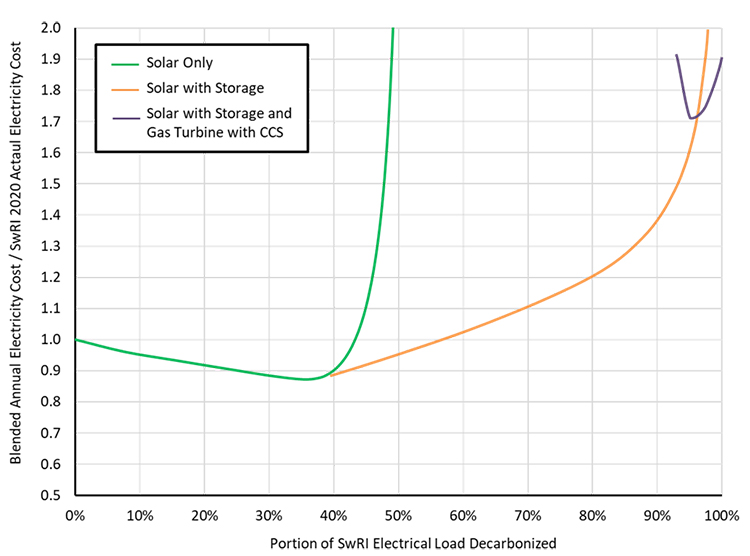Background
The recent shift in the global perspective of energy production strongly favors the development and implementation of renewable, decarbonized power. Recent executive orders from the United States government direct multiagency priority to target a carbon-pollution-free electricity sector during the next 15 years. Shifting the energy grid from the current non-renewable sources to new renewable or decarbonized non-renewable technologies presents a variety of challenges that could strain energy supplies. An initial evaluation of these technologies is being performed to identify and define pilot-scale systems that leverage commercial and government funding to create onsite net-zero cost-effective electricity production infrastructure at SwRI and to demonstrate new pilot-scale clean energy technologies for clients. A representation of the interacting decarbonized systems on SwRI’s site is shown below.

Figure 1: Interconnected Systems for Decarbonized Power.
Approach
The internal research-funded portion of Project Z conducted a feasibility study and performed conceptual design activities to define opportunities for onsite production of zero-carbon electricity. The project is investigating the SwRI campus characteristics and opportunities as a premiere location for clean energy research and pilot-scale demonstration to achieve U.S. decarbonization targets. The technical approach consisted of early feasibility study activities to evaluate SwRI’s electrical demand, site power requirements, and will document infrastructure and contractual agreements. Subsequently, the project team developed an analytical tool that evaluated onsite power generation technologies suitable for SwRI’s electricity usage, land availability, and natural gas/electric infrastructure at scales up to full-scale net-zero power generation. Estimates on the storage necessary to utilize excess renewable power were made and the trends in cost were examined, generating a roadmap for net zero emission on SwRI campus. The analytical tool is being further developed for modeling storage characteristics, industrial heat loads, and further expanding the renewable mix on campus. The team will monitor activities in progressing the decarbonization roadmap and updates to the analytical tool will generate new techno-economic predictions of the pathway to decarbonization at SwRI.
Accomplishments
The project completed a feasibility study of site infrastructure and conceptual design activities, which was required to evaluate and quantify pilot scale R&D infrastructure at SwRI for zero-carbon electricity generation. These activities included characterization of SwRI’s demand profile and definition of potential feasibility challenges due to contractual terms, land use, power quality and reliability requirements, and gas supply. Work was completed on more detailed techno-economic modelling and a down-selection of the candidate technologies based on the initial scoping analysis. The project subsequently developed a more detailed model of performance and cost dynamics with a flexible, analytical toolset that takes multiple sources and loads and creates a model of a decarbonized onsite power system. Systems were optimized based on cost of electricity versus the percentage of power that was decarbonized. Results helped determine which technologies are economically viable and the best path forward toward full decarbonization. A representation of the impact of multiple decarbonized systems on the SwRI cost of electricity versus the percent of load decarbonized is shown below.

Figure 2: Levelized Cost Projections versus Percent Decarbonization.
